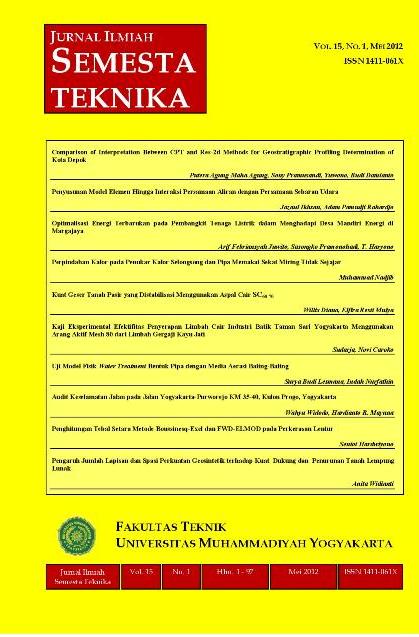Penyusunan Model Elemen Hingga Interaksi Persamaan Aliran dengan Persamaan Sebaran Udara
DOI:
https://doi.org/10.18196/st.v15i1.439Abstract
Aeration process is one of water treatment processes. The process consists of two physical phenomena, flow, and spreading of air bubble. This research has developed a finite element model for three-dimensional flow and spreading of air bubble. The flow equation employs Navier-Stokes equation. The spreading of air bubble is modeled as convection-diffusion equation. The Navier-Stokes and the spreading of air bubble equation are combined by Navier-Stokes equation with additional new term, which shows the accelerated flow caused by the air bubble moves. The Navier-Stokes equation was solved in four stages, i.e., Taylor Galerkin convection approximation, viscous prediction, pressure correction and velocity correction stages. Galerkin Standard method was used to solve the spreading of air bubble equation. Quadratic brick finite elements with 20 nodes were used on the geometry. To show performance model, comparison to the result of air bubble investigation was carried out. The numerical model that has been obtained is capable of simulating the phenomena of air bubble spreading and flow. The numerical stability analyses showed that the numerical scheme of convection and diffusion equation based on Galerkin is stable for Courant Number £ 0.01 and Peclet Number <125.
Downloads
Published
How to Cite
Issue
Section
License
Semesta Teknika is licensed under a Creative Commons Attribution 4.0 International License.
Authors who publish with this journal agree to the following terms:
- Authors retain copyright and grant the journal right of first publication with the work simultaneously licensed under a Creative Commons Attribution License that allows others to share the work with an acknowledgement of the work's authorship and initial publication in this journal.
- Authors are able to enter into separate, additional contractual arrangements for the non-exclusive distribution of the journal's published version of the work (e.g., post it to an institutional repository or publish it in a book), with an acknowledgement of its initial publication in this journal.
- Authors are permitted and encouraged to post their work online (e.g., in institutional repositories or on their website) prior to and during the submission process, as it can lead to productive exchanges, as well as earlier and greater citation of published work (See The Effect of Open Access).









